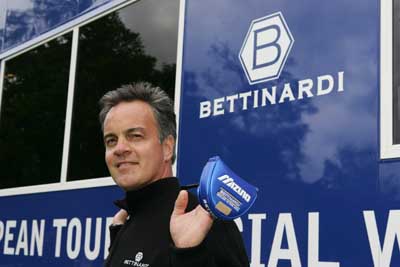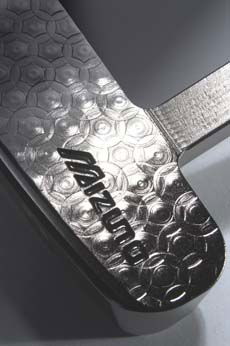Meet the master putter-maker
Face-to-face with Bob Bettinardi, soon to launch a new range of putters for Mizuno

Simply that you should be able to pick up a putter and think "Wow, I could hole some putts with this". That’s based on appearance. My whole concept on putters is based on looks. I was in a pro shop the other day, and there were about 30 putters. Only two looked good to my eye. Mentally, that has to go through your head. If it looks good to you, it’s probably going to feel good.
Absolutely. Too many of us select putters based on the technology. I would like to see that reversed. People will read an article that says ‘This putter has the biggest Moment of Inertia you can find.’ They’ll buy it without even looking at it. But you can put it down behind the ball and get no confidence from it. It could look like a brick on the end of stick.
Yes, but you don’t have to compromise on style. My one-piece putter design is a good example. Most putter makers weld the putter’s hosel to its head using heat. Any time you apply heat to metal you are affecting its purity, its integrity. The feel is not going to be quite there. When I started out making putters, I questioned why we had to use welding. Why couldn’t we not make head and hosel from one piece of metal? We set our hi-tech CNC (computer numerical control machinery to work on a single block of carbon steel, effectively sculpting head and hosel from it. When we tested the result, there was such a huge difference in feel and solidness of strike. So now all our putters are one-piece head and hosel. The technology is there, but it doesn’t affect the looks of the putter.
Currently, Nick Price, Bill Andrade, Lee Janzen, Bob Tway, Charles Howell III, Rocco Mediate and Olin Browne are using Bettinardi models. Jim Furyk used one to win 2003 US Open and Vijay Singh followed suit at the 2004 US PGA. My putters have been used for 40 Tour wins; Phil Mickelson has used one to win at the Colonial, while Luke Donald has used one on-and-off for the past eight years.
Precision, performance and excellence. My background is mechanical engineering. That world is all about high tolerances, quality and precision. I simply transferred those values into building my putters.
In 1990, before I designed any putters, I ran my own metal manufacturing business. I had a mechanical engineering degree, and had also learned about metals from my dad, who made small metal products for several industries. One day I saw a poster for a Callaway putter in a pro shop. It showed this picture of an ancient milling machine. I found myself asking: ‘Why would they make that putter with this old machine? Why wouldn’t they make it with the modern machines that we have?’ | |
At this time, in my factory we were using high tolerance CNC (Computer Numerical Control) milling machines – huge, powerful and precise – that cost around $350,000 a piece. They carve and sculpt metal using motors and computerised equipment. Maybe Callaway just didn’t know this new technology was available. I spoke to R&D (research and development) departments at Cleveland and Callaway and convinced them to let me build them a putter. It took us three months to do it but they loved the end product.
Jesper Parnevik helped a lot here. In our first week out on Tour, at Greensboro in 1999, Jesper asked if he could use one of our putters. He won, shooting 23 under par, with 99 putts for four rounds. He then won the Bob Hope Classic, shooting 27 under. That gave me the credibility for Bettinardi putters. When you have players who win with your product, that’s the stepping stone.
Our mindset is the same; there is an emphasis on quality and precision. Plus we are both manufacturers, designing and building our own products. I believe my products fit in well with Mizuno’s brand values.
We wanted to present golfers with a clear choice. So we have the A series – two mallet headed putters made from aluminium – and the C series, carbon steel, heel-toe weighted designs. The A series has more game improvement features. There is a sight line, as an alignment aid; the weight is back from the face, which stops it twisting on off-centre hits; and the blade is face-balanced, promoting squareness. The C series has more of a classic look. The feel is still soft, yet the metal gives the ball a solid click sound off the face. There are three head styles, each with a satin pearl finish.
It stands for Heavy. The putters come in two lengths, 34 and 35- inch. The shorter putter being 10 grams heavier to keep the overall swingweight up.
I have a hi-tech facility in Illinois called Studio B. It is staffed by 60 technicians and has a 100ft putting green. We’ve installed a four-camera laser vision system, which sends 200 frames per second to a 40-inch plasma screen. We can watch in minute detail what happens when the ball leaves the putterface.
I make products for the dental industry, but more interestingly I make the casings for the ‘brain’ of a smart bomb. We use a very strong grade of stainless steel – and the design must meet very tight tolerances. Finally, what’s the strangest putter you’ve been asked to make? Rocco Mediate once had me use sterling silver for a face insert. He wanted a different feel off the putter face. He said ‘I don’t care what it costs, just make it’. I charged him $3000. Unfortunately the face felt just like aluminium. I could have given him the same feel for 300 bucks. He hasn’t used it for a year now.
Golfmagic has over 3,000 items of equipment reviewed within its system, many of which golfers use to consider their purchases. Most, too, can be bought from our shopping partners, which are listed on the left-hand side of every page. |



